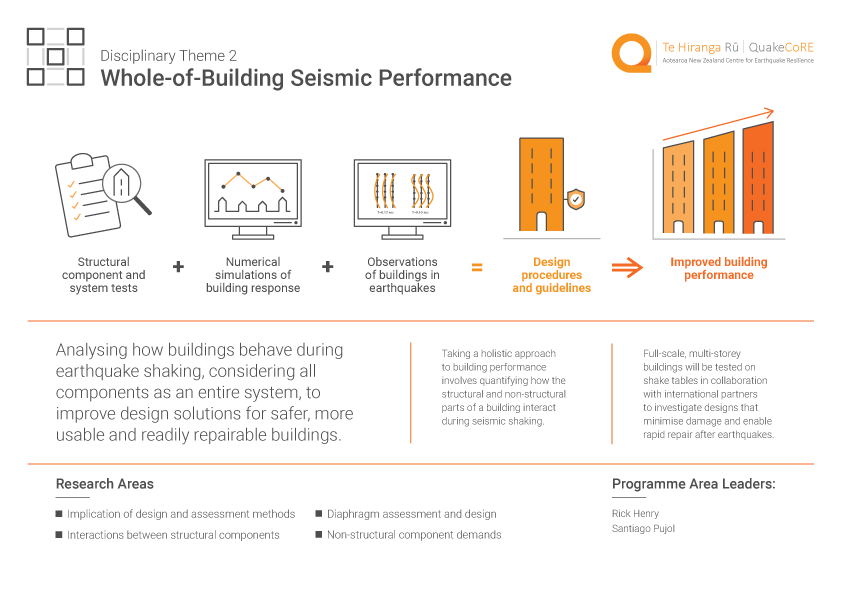Develop fundamental understanding, and methods and models for the quantification of, whole-of-building seismic performance through direct consideration of structural and non-structural component interactions, as well as advances in seismic design and assessment considering life-cycle analysis.
Research Summary
The goal of this programme is to develop fundamental understanding, and methods and models for the quantification, of whole-of-building seismic performance through direct consideration of interactions between structural and non-structural components, as well as advances in seismic design and assessment considering a whole-of-life approach. Idealization of building systems during design often leads to components being considered in isolation without fully accounting for the performance of the building as a whole. As society increasingly demands safe, resilient, and repairable buildings there is a greater need to consider buildings as a ‘holistic’ system in order to ensure continued functionality after a range of earthquake scenarios. Key thrusts of this research will include interactions between structural components, floor diaphragm assessment and design, non-structural component demands and interactions, and implication of design decisions and methods. The mechanics of component interactions will be investigated using a combination large-scale structural testing, data from international collaborative building tests (past and new), and field observations of the performance of building in earthquakes. These data sources will be used to develop and vet methods of modelling component interactions using state-of-art numerical simulations. Synthesis and translation of these models to design methods will result in immediate improvements in building resilience.
Research Outline
Key research thrusts within DT2 and associated objectives include:
- Implication of design and assessment methods:
1.1 Quantify the impact of reducing drift limits on seismic design and post-EQ outcomes
1.2 Investigate the design of nominally ductile structures for lower-drift buildings
1.3 Comparison of performance of structural systems across all limit state
1.4 Reimagining %NBS for seismic assessment of existing buildings - Interactions between structural components:
2.1 Investigate the interaction between lateral load resisting systems and floors
2.2 Investigate the interaction between different lateral load resisting systems
2.3 Investigate the interaction between connected buildings - Diaphragm assessment and design:
3.1 Refine seismic assessment methods for precast floor diaphragms in existing buildings
3.2 Quantify the response of irregular floor diaphragms
3.3 Investigate the design of emerging alternative floor systems - Non-structural component demands:
4.1 Investigate the interaction between different NSE and between structural systems and NSE.
4.2 Quantify the acceleration and drift demands on NSE.
Our People
Programme Leaders: Rick Henry, Santiago Pujol
Researchers: Derek Baxter, Sherif Beskhyroun, Nicholas Brooke, Des Bull, Nigel Colenso, Patrick Cummuskey, Enrique Del Ray Castillo, Rajesh Dhakal, Ashkan Hashemi, Lucas Hogan, Jared Keen, Chin-Long Lee, Angela Liu, Quincy Ma, Gregory MacRae, Maxim Millen, Stuart Oliver, Pierre Quenneville, Shahab Ramhormozian


